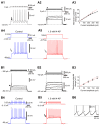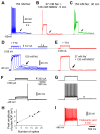Molecular, Morphological and Electrophysiological Differences between Alpha and Gamma Motoneurons with Special Reference to the Trigeminal Motor Nucleus of Rat
- PMID: 38791305
- PMCID: PMC11121624
- DOI: 10.3390/ijms25105266
Molecular, Morphological and Electrophysiological Differences between Alpha and Gamma Motoneurons with Special Reference to the Trigeminal Motor Nucleus of Rat
Abstract
The muscle contraction during voluntary movement is controlled by activities of alpha- and gamma-motoneurons (αMNs and γMNs, respectively). In spite of the recent advances in research on molecular markers that can distinguish between αMNs and γMNs, electrophysiological membrane properties and firing patterns of γMNs have remained unknown, while those of αMNs have been clarified in detail. Because of the larger size of αMNs compared to γMNs, blindly or even visually recorded MNs were mostly αMNs, as demonstrated with molecular markers recently. Subsequently, the research on αMNs has made great progress in classifying their subtypes based on the molecular markers and electrophysiological membrane properties, whereas only a few studies demonstrated the electrophysiological membrane properties of γMNs. In this review article, we provide an overview of the recent advances in research on the classification of αMNs and γMNs based on molecular markers and electrophysiological membrane properties, and discuss their functional implication and significance in motor control.
Keywords: Ca2+-activated cationic channel-mediated ADP; LTS; NeuN; early outward rectification; estrogen-related receptor 3; flufenamic-acid-sensitive ADP; α-motoneuron; γ-motoneuron.
Conflict of interest statement
The authors declare no conflicts of interest.
Figures








Similar articles
-
Electrophysiological and Morphological Properties of α and γ Motoneurons in the Rat Trigeminal Motor Nucleus.Front Cell Neurosci. 2018 Jan 24;12:9. doi: 10.3389/fncel.2018.00009. eCollection 2018. Front Cell Neurosci. 2018. PMID: 29416504 Free PMC article.
-
A distinct functional distribution of α and γ motoneurons in the rat trigeminal motor nucleus.Brain Struct Funct. 2017 Sep;222(7):3231-3239. doi: 10.1007/s00429-017-1400-8. Epub 2017 Mar 22. Brain Struct Funct. 2017. PMID: 28326439
-
The physiological and morphological characteristics of interneurons caudal to the trigeminal motor nucleus in rats.Eur J Neurosci. 2003 Dec;18(11):2981-98. doi: 10.1111/j.1460-9568.2003.03030.x. Eur J Neurosci. 2003. PMID: 14656294
-
Trigeminal premotor neurons in the bulbar parvocellular reticular formation participating in induction of rhythmical activity of trigeminal motoneurons by repetitive stimulation of the cerebral cortex in the guinea pig.J Neurophysiol. 1993 Feb;69(2):595-608. doi: 10.1152/jn.1993.69.2.595. J Neurophysiol. 1993. PMID: 8459288
-
Electrical properties of interneurons found within the trigeminal motor nucleus.Eur J Neurosci. 2008 Sep;28(6):1136-45. doi: 10.1111/j.1460-9568.2008.06413.x. Epub 2008 Sep 9. Eur J Neurosci. 2008. PMID: 18783374
Cited by
-
Morphological segmentation with tiling light sheet microscopy to quantitatively analyze the three-dimensional structures of spinal motoneurons.Cell Regen. 2025 May 14;14(1):17. doi: 10.1186/s13619-025-00231-3. Cell Regen. 2025. PMID: 40360768 Free PMC article.
-
Exercise, disease state and sex influence the beneficial effects of Fn14-depletion on survival and muscle pathology in the SOD1G93A amyotrophic lateral sclerosis (ALS) mouse model.Skelet Muscle. 2024 Oct 14;14(1):23. doi: 10.1186/s13395-024-00356-0. Skelet Muscle. 2024. PMID: 39396990 Free PMC article.
References
-
- Matthews P.B.C., Bagby R.M. Mammalian muscle receptors and their central actions. Med. Sci. Sports Exerc. 1974;6:iv. doi: 10.1249/00005768-197400620-00005. - DOI
-
- Phillps C.G. Motor apparatus of the baboon’s hand. Ferrier Lect. 1969;173:141–174. - PubMed
-
- Desmedt J.E. Motor Control Mechanisms in Health and Disease. Raven Press; New York, NY, USA: 1983.
-
- Tsukiboshi T., Sato H., Tanaka Y., Saito M., Toyoda H., Morimoto T., Türker K.S., Maeda Y., Kang Y. Illusion caused by vibration of muscle spindles reveals an involvement of muscle spindle inputs in regulating isometric contraction of masseter muscles. J. Neurophysiol. 2012;108:2524–2533. doi: 10.1152/jn.00997.2011. - DOI - PubMed
Publication types
MeSH terms
Grants and funding
LinkOut - more resources
Full Text Sources
Miscellaneous

